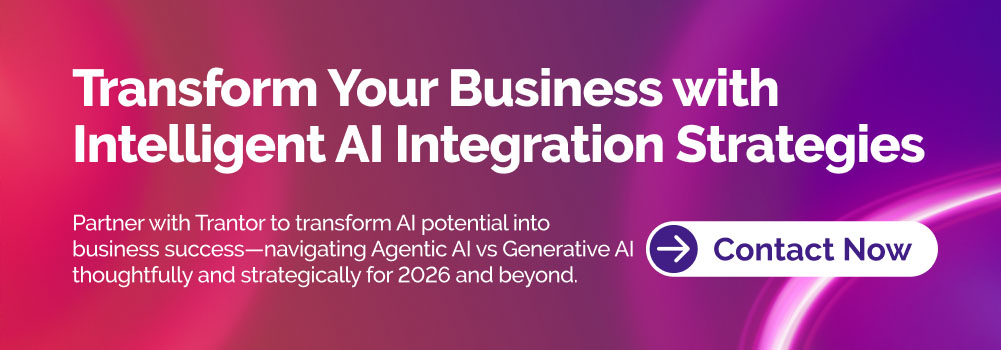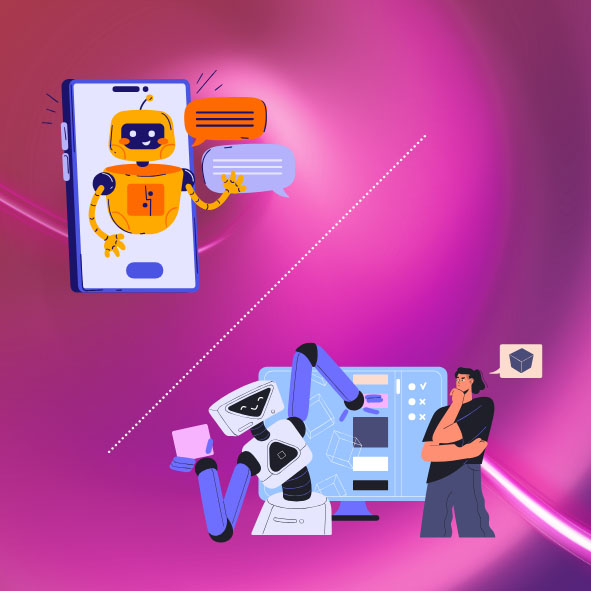Artificial Intelligence, zBlog
Agentic AI vs Generative AI: A Comprehensive Guide for 2026
trantorindia | Updated: September 10, 2025
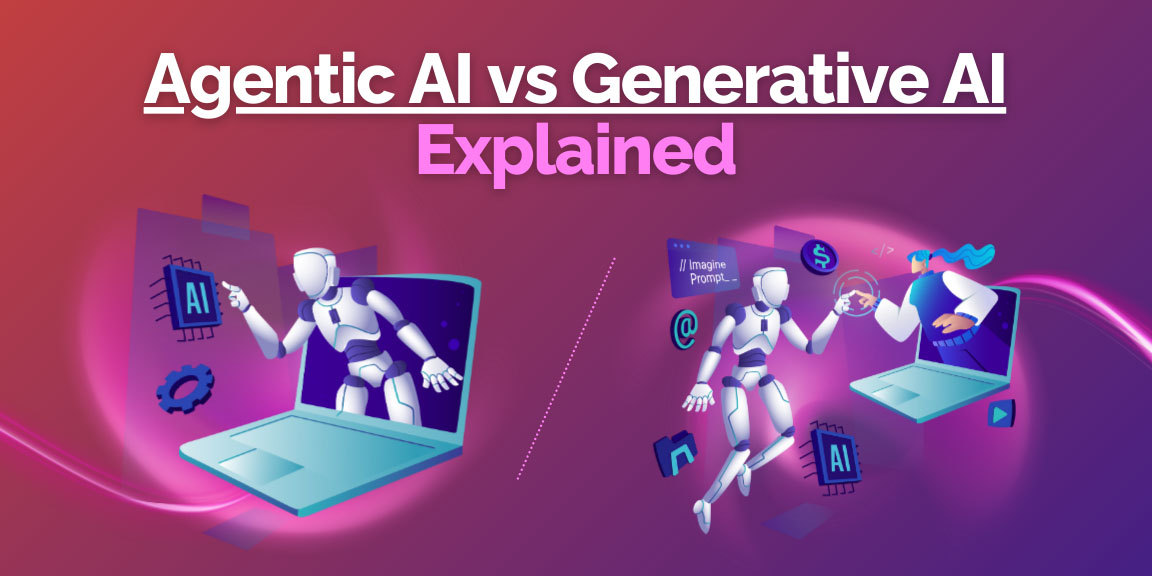
The landscape of artificial intelligence is evolving rapidly, bringing forth new technologies that are transforming how businesses operate, innovate, and engage with customers. Among these advancements, Agentic AI and Generative AI have emerged as game-changing paradigms. Though sometimes used interchangeably, the concepts of Agentic AI vs Generative AI represent fundamentally different approaches to AI’s capabilities, autonomy, and applications.
This detailed guide dives into Agentic AI vs Generative AI, comparing their definitions, capabilities, use cases, and benefits to help organizations strategize their AI adoption. You will discover how these technologies work individually and synergistically, uncover current trends, survey insights, and best practices for leveraging them effectively in 2026’s digitally driven world.
Understanding Agentic AI vs Generative AI: Clear Definitions
What Is Generative AI?
Generative AI focuses on creating new content based on learned data patterns. It generates text, images, audio, video, software code, and more by responding to prompts with creative outputs. Powered by sophisticated deep learning models—especially large language models (LLMs)—Generative AI excels at mimicking human-like creativity and language understanding. Examples include ChatGPT, DALL·E, and Google’s Gemini AI.
Key traits of Generative AI:
- Reactive: Responds to user inputs and prompts.
- Content-centric: Creates original content like reports, campaigns, designs.
- Data-driven learning: Learns from massive data corpora but does not act autonomously.
- Applications: Content creation, brainstorming, code generation, multimedia synthesis.
What Is Agentic AI?
Agentic AI refers to AI systems endowed with goal-oriented autonomy—they don’t just generate outputs but independently decide, plan, and act to achieve objectives with minimal human intervention. Agentic AI blends the adaptable intelligence of LLMs with persistent decision-making, reinforcement learning, and real-world environmental interaction.
Key traits of Agentic AI:
- Proactive: Initiates actions based on context without explicit prompts.
- Autonomous: Plans and completes multi-step processes.
- Adaptive: Learns and revises behaviors through reinforcement and feedback.
- Applications: Autonomous trading systems, AI-driven supply chains, virtual assistants with execution authority.
Core Differences Between Agentic AI vs Generative AI
How Agentic AI and Generative AI Work Together
In modern organizations, the distinction between Agentic AI vs Generative AI is blurring as they form complementary forces driving intelligent automation:
- Creative Generation: Generative AI crafts content such as marketing emails, social media posts, sales proposals, and product descriptions.
- Execution & Optimization: Agentic AI autonomously plans campaigns, schedules deliveries, personalizes customer journeys, and iteratively optimizes workflows based on performance.
- Feedback Loop: Agentic AI uses data from engagement and outcomes to refine generative prompts, improving creative relevance.
Example: Launching an AI-driven email campaign.
- Generative AI writes personalized email variants.
- Agentic AI chooses the right audience, schedules dispatch, monitors open rates, and dynamically adjusts content or timing for optimal performance.
This synergy transforms long, manual processes into autonomous workflows delivering real-time adaptability and scale.
Benefits of Agentic AI vs Generative AI
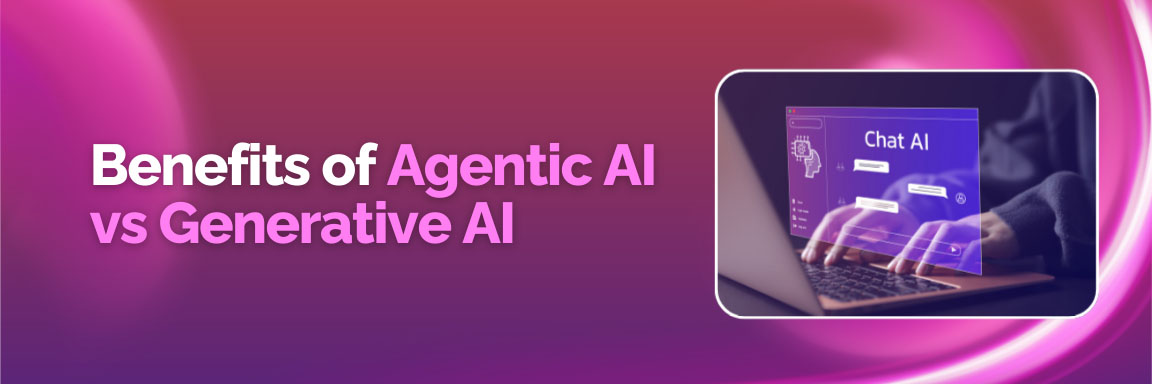
Benefits of Generative AI
- Drives content innovation at scale.
- Accelerates ideation and creative processes.
- Reduces dependency on human content creators.
- Enables multilingual and cross-modal content production.
Benefits of Agentic AI
- Automates complex workflows without continual human intervention.
- Improves decision accuracy by continuously learning and adapting.
- Reduces operational costs via autonomous task execution.
- Enables rapid scaling of business processes with minimal manual effort.
Key Use Cases for Agentic AI vs Generative AI
Emerging Trends in Agentic AI vs Generative AI (2025–2026)
- Increased AI Ecosystem Integration: Enterprises embed generative modules inside agentic platforms powering seamless AI workflows.
- Domain-Specific LLMs: Tailored generative AI models deliver precise outputs for vertical industries like healthcare, finance, and legal.
- Responsible AI and Trust Layers: Transparency, fairness, and compliance are built into AI systems, important for autonomous actions.
- On-Device and Edge AI: Agentic AI advances with real-time local decision making, reducing reliance on cloud latency.
- Multimodal AI: Both AI paradigms expand into audio, video, and sensor integration enabling rich autonomous agent interactions.
Challenges and Considerations
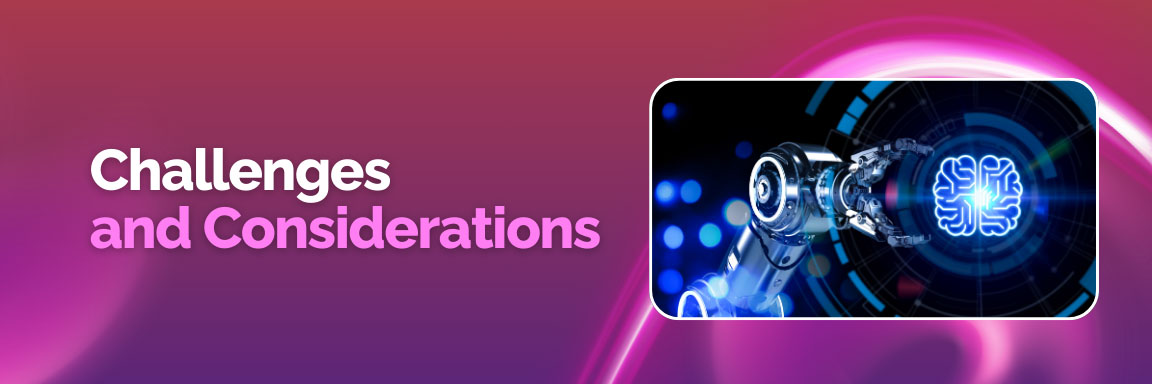
- Data Quality & Bias: Both paradigms rely on vast data; flawed inputs yield poor or unethical outcomes.
- Infrastructure Investment: Agentic AI necessitates sophisticated infrastructure for orchestration, security, and scale.
- Human Oversight Balance: Balancing autonomy with safety requires human-in-the-loop frameworks.
- Ethical and Legal: Autonomous AI actions raise novel accountability and governance questions.
- Skillset Barriers: Organizations need new multidisciplinary skills spanning data science, ML engineering, business operations, and ethics.
Best Practices for Leveraging Agentic AI and Generative AI

- Define Clear Objectives: Align AI adoption tightly with measurable business outcomes.
- Pilot Use Cases: Start small, prove value, and scale iteratively.
- Combine AI Types: Embrace the synergy of Agentic AI vs Generative AI rather than choosing exclusively.
- Invest in Data Governance: Ensure reliable, ethical, and compliant data pipelines.
- Human–AI Collaboration: Design workflows requiring human intervention where risk or ambiguity is high.
- Continuous Monitoring: Track AI behavior and outcomes, adapting models dynamically.
Survey Insights and Market Data
- IBM reports 70% of enterprises have deployed or plan agentic AI-driven automation by 2025.
- McKinsey projects generative AI will unlock $4.4 trillion in annual economic value by 2026.
- Gartner forecasts AI-powered autonomous agents will handle 40% of digital tasks in leading organizations by 2026.
- Companies using agentic AI experience up to 30% efficiency improvements and 25% cost reductions compared to traditional automation.
- Ethical AI adoption and transparency rank as top priorities for 85% of AI project leaders in 2024 surveys.
Frequently Asked Questions (FAQs)
Q1: Can agentic AI and generative AI replace human workers?
No, these technologies augment human capabilities, automating repetitive or complex tasks while humans provide strategic oversight, creativity, and judgment.
Q2: Are generative AI and agentic AI competitors?
No, they complement each other. Generative AI creates content, agentic AI autonomously executes flows and decisions.
Q3: What industries benefit most from agentic AI?
Finance, healthcare, supply chain, marketing, and customer service see high impact due to workflow complexity and volume.
Q4: How do I choose between agentic AI and generative AI?
Base the choice on your needs: content creation or autonomous process execution. Often, integrating both yields maximum value.
Q5: What governance is needed for agentic AI?
Robust oversight, transparency, auditability, and human-in-the-loop mechanisms mitigate risks inherent in autonomous AI actions.
Conclusion: Harnessing Agentic AI and Generative AI with Trantor
In the evolving AI landscape, Agentic AI vs Generative AI is not an either/or choice but a powerful combination that drives comprehensive digital transformation. By leveraging generative AI’s creative capabilities alongside agentic AI’s autonomous decision-making, organizations unlock unprecedented agility, efficiency, and innovation.
At Trantor, we guide clients through the complexities of integrating these cutting-edge AI paradigms into tailored, ethical, and scalable solutions. Our expertise ensures your AI initiatives deliver measurable value while maintaining trust and compliance.
